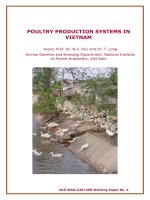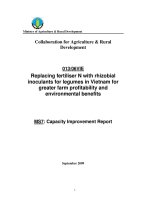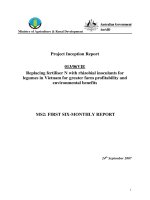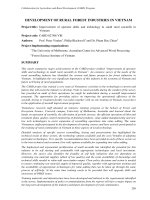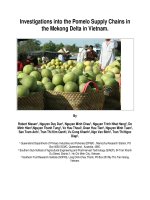Coral reefs in Vietnam
Bạn đang xem bản rút gọn của tài liệu. Xem và tải ngay bản đầy đủ của tài liệu tại đây (1.38 MB, 4 trang )
VIETNAM 2009
Coral reefs in Vietnam
The coral reefs in Ha Long Bay have
suffered from several sources of damage
such as coral bleaching and destructive
fishing practices. To address some of
these problems, PTES has partly funded
a project covering an area measuring
400m2. The project focuses on trial coral
transplantation using various artificial
substrates on different degraded reef sites.
In addition, the project also increases
public awareness by teaching the local
communities the importance of protecting
their coral reefs for future generations.
Day 2
Institute of Marine Environment
and Resources
Nguyen Van Quan has had a huge role in
this project and will therefore be your guide
during your stay in Vietnam. You will also
be accompanied by a representative from
PTES.
After lunch, you will travel onto Ha
Long Bay, which is located in Northeast
Vietnam. Here the coral reefs maintain the
highest biodiversity in north Vietnam.
In the morning you will visit the Institute
of Marine Environment and Resources
to learn about the work currently being
carried out on coral reefs in Vietnam.
You will be given an insight into what is
involved in preserving coral reefs. You
will then travel to Do Son town to see the
mangrove forests and to view the beatiful
landscape of this coastal town. Here you
will have lunch.
You will spend this evening in Ha Long
Bay Hotel.
Day 3
Ha Long Bay
Today you will have a short visit to the
Ha Long Bay Management board as well
as exploring the coral restoration site at
Cong Do.
Day-by-Day Itinerary
In the afternoon, you will have some time
to go swimming off Titof Island, which
is close to Ha Long Bay. The afternoon
will be spent relaxing and taking in your
amazing surroundings.
Day 4
Day 1
Limestone cave systems
with thick jungle vegetation, which rise
spectacularly from the ocean. Several of
the islands are hollow, with enormous
caves.
Day 5
Cat Ba Island
In the morning you will visit the floating
village at Cua Van in Ha Long Bay. The
floating villages of fishermen ply the
shallow waters for 200 species of fish and
450 different kinds of mollusks.
You will then move onto the Cat Ba Islands.
The islands lie on a main migration
route for many species of waterfowl. The
beaches and mangrove forests provide
feeding and roosting sites for a large
number of birds during the migration
season, including several species of
ducks, geese and shorebirds. Resident
and migrant species include the little
grebe, spotbill duck and the whitebreasted water-hen.
After checking into the Princess Hotel, you
can take part in some snorkeling around
the local coral reef sites.
Day 6
Cat Ba National Park
Today, you will explore the tropical
rainforest at the Cat Ba National Park,
as well as visiting a centre for the
conservation of the white headed Langur
- a unique and endangered species.
The Adventure Begins
Meet your PTES representative at
Heathrow airport for your flight to Noi
Bai International Airport in Vietnam. On
arrival, you will be greeted by Nguyen Van
Quan. You will then check into the Bach
Dang Hotel in Hai Phong City.
After breakfast, you will spend the whole
day exploring the breathtaking limestone
cave system in Ha Long Bay, also known as
“the amazing paradise on earth”.
The bay consists of a dense cluster of 1,969
limestone monolithic islands, each topped
The fauna in Cat Ba National Park has
not been studied in detail but the island
does not appear to support the large
mammals or carnivores found on the
mainland. However, preliminary surveys
have revealed that the fauna is distinctive
with unique elements adapted to
VIETNAM 2009
island conditions. One such endemic
is a subspecies of Francois’ monkey.
Other mammals known to occur include
leopards, bears and the European otter.
Day 7
Viet Hai eco-village
For your last full day in Vietnam, you will
visit the Viet Hai eco-village.
A pilot project has been carried out
to raise awareness of eco-tourism
opportunities and to demonstrate that
sustainable tourism practices can provide
higher-yield, lower-impact benefits.
Activities have included training
hotels in eco-certification standards
for energy and water use, building the
capacity of a local hotel association,
promoting traditional architecture and
performances to attract eco-tourists,
and developing a community-based
cooperative in Viet Hai, a village in Cat Ba
National Park.
Residents involved in tourism
development have visited other areas
of Vietnam and Thailand to learn best
practices in developing tourism that
helps the poor.
Day 8
Please note, this itinerary is a GUIDE ONLY.
Due to circumstances beyond our control,
as well as to maximise opportunities for
seeing animals, the following itinerary may
be subject to change.
Goodbye
Having spent your last night in the Princess
Hotel, today you will transfer back to Ha
Long Bay before returning to Noi Bai
International Airport.
No sightings of species are guaranteed
as they are wild animals and we cannot
restrict their natural movements, nor
indeed would we wish to.
The region
Geography
Ha Long Bay is located in Northeast
Vietnam and belongs to the Quang Ninh
Province. Ha Long Bay stretches from
the Yen Hung District, and includes large
urban areas of Halong City and Cam
Pha Town, as well as the Van Don Island
District. The area has been recognised as a
home of ancient Viet people. Ha Long Bay
maintains an extremely rich biodiversity.
The Cat Ba Biosphere Reserve, which is
in northern Vietnam, is internationally
important for its limestone karst
geomorphology. It also has one of the best
examples in the world of a fengcong and
fenglin karst landscape.
The 366 limestone islands have
numberous cave deposits that provide
evidence of a long history of erosion
and landscape evolution. Many of the
small islands rise steeply or vertically
from the shallow marine waters and are
the distinguishing feature of the region.
Most of the bigger islands are covered by
evergreen tropical monsoon forest. The
largest island of the archipelago has a
surface of 285 km2 and includes the Cat Ba
National Park.
Cat Ba encompasses a mosaic of land types
derived from human uses such as bushes
and woodland, limestone karst, limestone
forest, agricultural areas, bamboo forest,
mangrove and sea grass beds. The
archipelago is of global importance due to
the high number of endemic species.
The golden-headed langur
(Trachypithecus poliocephalus) is a species
endemic to the Cat Ba Island and is listed
as one of the rarest primates in the world
due to its restricted range and small
population size.
History
The history of Vietnam begins around
2,700 years ago. Successive dynasties
based in China ruled Vietnam directly for
most of the period from 111 BC until 938
when Vietnam regained its independence.
Vietnam remained a tributary state to
its larger neighbour China for much of
its history but repelled invasions by the
Chinese as well as three invasions by
the Mongols between 1255 and 1285.
King Trần Nhân Tông later diplomatically
submitted Vietnam to a tributary of
the Yuan to avoid further conflicts. The
VIETNAM 2009
Coral reef
transplantation
project
independent period temporarily ended in
the middle to late 19th century, when the
country was colonized by France.
During World War II, Imperial Japan
expelled the French to occupy
Vietnam, though they retained French
administrators during their occupation.
After the war, France attempted to reestablish its colonial rule but ultimately
failed. The Geneva Accords partitioned
the country in two with a promise of
democratic election to reunite the country.
However, rather than peaceful
reunification, partition led to the Vietnam
War, a civil war and a major part of the
Cold War. During this time, the People’s
Republic of China and the Soviet Union
supported the North while the United
States supported the South. After millions
of Vietnamese deaths and the American
withdrawal from Vietnam in March 1973,
the war ended with the fall of Saigon to
the North in April 1975.
The reunified Vietnam suffered further
internal repression and was isolated
internationally due to the continuing
Cold War and the Vietnamese invasion of
Cambodia. In 1986, the Communist Party
of Vietnam changed its economic policy
and began reforms of the private sector
similar to those in China.
Since the mid-1980s, Vietnam has enjoyed
substantial economic growth and some
reduction in political repression.
Food
Vietnamese cuisine is known for its
common use of fish sauce, soy sauce, rice,
fresh herbs, fruits and vegetables.
Vietnamese recipes use many vegetables,
herbs and spices, including lemon grass,
lime, and kaffir lime leaves. Throughout all
regions of Vietnam, the emphasis is always
on serving fresh vegetables and/or fresh
herbs as side dishes along with dipping
sauce.
The Vietnamese also have a number of
Buddhist vegetarian dishes. The most
common meats used in Vietnamese
cuisine are pork, beef, chicken, shrimp,
cockles and various kinds of seafood. Duck
and goat are used less widely.
A typical meal for the average Vietnamese
family would include:
- Individual bowls of rice
- A grilled, boiled,steamed, stir fried (with
vegetable) or stewed, meat or fish or other
seafood dish
-A stir-fried steamed vegetable dish
- Canh (a clear broth with vegetables
and often meat or seafood) or other
Vietnamese-style soup
- Prepared fish sauce and/or soy sauce for
dipping
All dishes are communal and to be shared
apart from the individual bowls of rice.
The transplantation of the coral
colonies in order to boost the
recovery of the coral reef at the
degraded reef sites can be carried
out feasibly by using artificial
substrate with coral fragments.
After 3 months (April to July 2005),
the coral survival rate was relatively
high (85-90%). Many coral colonies
have attached to the surface of the
substrate, with only a few of them
falling out of the substrate. The
coral colonies have kept developing
which will contribute to the coral
larval sources in the future. The
lessons learned through the project
include:
The selection of site: it is necessary
to do the transplant work on the
high embankment to avoid direct
strong wave movements. The
tropical storms that normally occur
during August and September in Ha
Long Bay have a huge influence on
the site.
The selection of the substrate
model: this contributes to the
success of any coral rehabilitation
project. The suitable substrate has
to be the right balance between
effective conservation value (high
coral survival rate) and economic
value (low cost technique). In this
project, the low cost technique
has been applied and has received
positive feedback.
Public education awareness
program: ideally this program
would involve the fishermen
Continued overleaf
VIETNAM 2009
to participate in the coral
restoration work. From experience,
a lot of support has come from the
local fishermen.
The technical transferring
process has been carried out by
involvement of the staff at the Ha
Long Bay Management
Department through an
agreement with the Institute
of Marine Environment and
Resources. The enforcement
team of Ha Long Bay Management
Department have played a vital
role in the project.
Essential traveller’s information
DATES Wednesday 13th - Wednesday 20th May
GROUP SIZE 10
ACCOMMODATION Your accommodation will be in comfortable staying in hotels
throughout your trip, with ensuite rooms whenever possible.
FOOD Breakfast and dinner will be served in your hotel or a local restaurant.
Lunches will either be picnics or in a local restaurant.
FITNESS You will get the most enjoyment out of the trip if you are able to walk for
reasonably long distances at an unhurried pace. You are more likely to see wildlife
if you leave the main roads and take to trails and paths but there is no reason why
you can not take a day to rest if you prefer.
CLIMATE In May the tempretaure ranges from 25-30 degree Celsius. It may
occasionally rain so please bring an umbrella.
TOUR COST £700 per person based on two sharing. Price includes
accommodation, all meals, ground transportation and excursions, services of local
guides. Not included are flights, travel insurance, drinks and spirits, souvenirs etc.
SINGLE ROOM SUPPLEMENT £100. Please note, we will try to find single travellers
who would prefer to share a room.
FLIGHT COST £600 including taxes. Prices are not guaranteed until all deposits
have been paid and are correct at time of printing (September 2008).
TRAVEL INSURANCE Travel insurance is compulsory. You must have adequate
travel and medical/rescue insurance to cover the whole of your journey. Please see
our optional travel insurance offer for details.
PASSPORT & VISAS Please ensure that you have a full 10 year passport, which is
valid for at least six months after your return date. A short term tourist visa is
necessary for your visit.
RESERVATION & INFORMATION To reserve your place please fill in the enclosed
booking form and return with the necessary deposits to PTES. If you have any
questions, please call 020 7498 4533 or e-mail
The initial success of the coral
transplantation at the degraded
reef sites has been illustrated by
the coral survival rate of 85-90%
after a year. These planted coral
colonies will contribute to the
future coral larvae source at the
reef sites.
The project has shown that low
cost techniques and following
simple procedures by
the local people in Ha Long
Bay makes a huge impact on
increaseing the conservation
activity in the area.
The initial results of coral
transplantation at these vulerable
sites brings hope that coral
recovery through physical
transplantation is possible and
should be something which
continues into the future, to
ensure these amazing habitats are
still around for future generations.
The Ha Long Bay Management
Department has decided to
continue with the coral
rehabilitation work in following
years.

